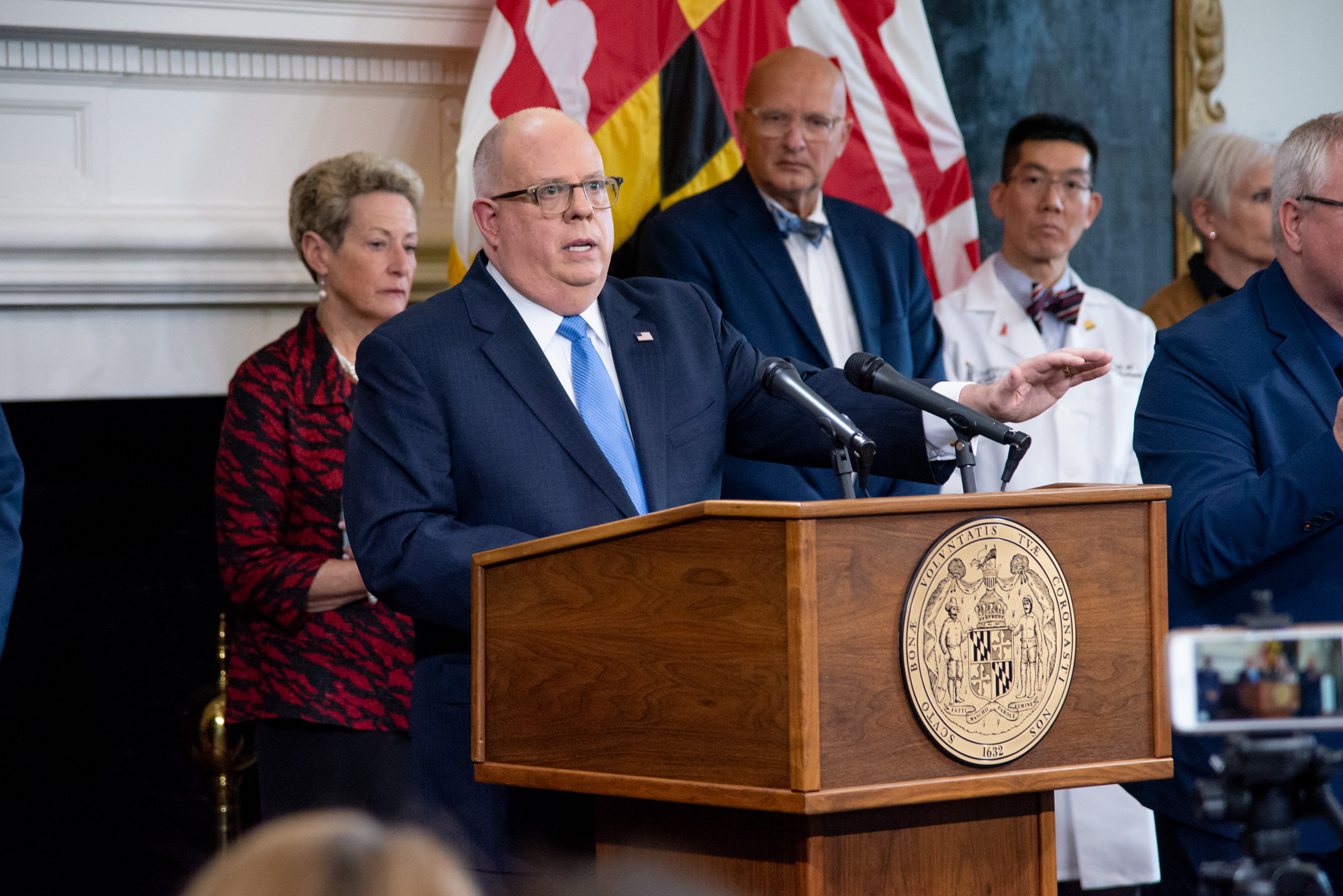After news reports last week identified Maryland as one of the worst states in the nation at administering COVID-19 vaccines, Gov. Larry Hogan held a press conference Tuesday defending the state’s vaccination plans and announcing new measures to bolster them.
At the press conference, Hogan said the state has distributed 98.7 percent of the vaccine doses it received from the federal government, but only a portion of those doses have been administered. While Maryland hospitals administered about 30 percent of distributed vaccines, Hogan said, nursing homes have had less than 14 percent of doses administered.
“Distributing and administering vaccines throughout 2021 will be, without question, the greatest peacetime undertaking in American history, and it will be a massive, all-hands-on-deck ongoing operation,” Hogan said.
In an article published Dec. 29, Bloomberg News reported Maryland ranked last among 20 states included in its calculation for administering alloted vaccine doses. According to the outlet’s assessment, Maryland had at the time administered only 10.9 percent of the vaccines it had been allocated, compared to the 50.5 percent rate of neighboring West Virginia. Comparatively, the nation’s overall rate sat at 19.3 percent, according to Bloomberg.
Hogan cited data reporting issues as one of the reasons for the low vaccine administration rate. The governor said he spoke earlier Tuesday with the CEOs of CVS and Walgreens — who have a federal contract to administer COVID-19 vaccines to nursing homes — and the CEO of CVS said the company has administered more doses than it has reported. CVS is working on correcting its reporting issues, Hogan said the company’s CEO informed him.
“Slow and uneven data reporting has made it extremely difficult to determine where there are issues with vaccine administration,” Hogan said.
[Here’s how UMD fits into recent COVID-19 testing investigations]
Another issue Hogan identified is the slow rate of vaccine production. Hogan said he currently expects Maryland will receive 72,000 vaccine doses per week, which means only 30 percent of the state’s population will be vaccinated by the end of May.
Hogan also announced he is expanding the priority list to receive the vaccine early. All state residents over the age of 75, teachers, child care workers, “high-risk inmates” and those living in special needs group homes are now among the populations included in Phase 1B of the vaccine roll-out, who Hogan anticipates will be able to be vaccinated at the end of January.
The state is currently in Phase 1A in its vaccination program, which includes over 500,000 Marylanders who are healthcare workers, residents and staff of nursing homes, first responders, public safety officers and correctional officers, among others. Phase 1B will include an estimated 860,000 state residents and Phase 1C will comprise about 772,000 Marylanders, including all residents ages 65 to 74 and workers in other critical sectors, such as public transit and manufacturing. Hogan estimates that phase will begin in March.
Hogan said the state’s education department will be working with school systems across the state to coordinate their vaccination plans.
“We ask everybody to be patient as this will be a long process,” Hogan said.
To improve the state’s vaccination efforts, Hogan announced effectively immediately, the state is adopting a vaccination model in which doses will be redirected to new facilities if the state determines there is inefficient distribution from any providers.
The Maryland Department of Health will be issuing an order today allowing the state to reduce the quantity of vaccine allocated to a healthcare facility if the facility does not administer 75 percent of its earlier allocation. Hogan also issued an executive order requiring providers to report vaccination data to the state within 24 hours after administration.
[All Maryland hospitals will have COVID-19 vaccine doses within two weeks]
“No doses should be sitting in freezers going unused, waiting or backing up while others are in need of more,” Hogan said.
In addition, Hogan announced the National Guard and Maryland Reserve Medical Corps will assist local health departments in expanding their vaccination capacity: Starting Wednesday, National Guard emergency vaccination teams will be dispatched across the state to vaccination clinics to help administer vaccines and provide logistical support.
Hogan said he also offered additional resources, such as personal protective equipment, logistical support and vaccinators, to the Maryland Hospital Association to help speed up the process of vaccinating critical hospital workers.
Hogan claims Maryland is currently ahead of 27 states in terms of its vaccine rollout.
However, issues still persist. According to state data, Black and Latino Marylanders represent 14 and 4 percent of those who have been vaccinated so far, despite making up 31 and 11 percent, respectively, of the state’s population, according to 2019 census data.
Hogan also said the Montgomery and Howard counties health departments are among the top five local health departments for administering the vaccine in the state, while the Prince George’s County and Baltimore City health departments are among the five worst.
The governor added that most states in America are facing similar issues with vaccine roll-out. He said Maryland has reached out to the National Governors Association to begin “joint dialogue” with other state leaders, federal partners and the pharmacies administering the vaccines.
“While none of us are thrilled with the pace of this rollout over the first couple of weeks, I can assure you that is improving every day,” Hogan said.



